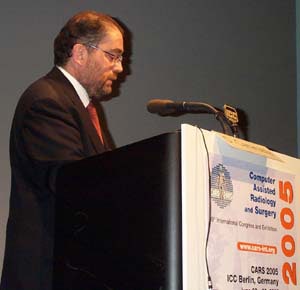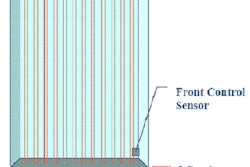
BERLIN - After 23 years of academic research and commercial evolution into a clinically viable technology, does PACS merit another decade of additional R&D by the medical academic community?
Dr. Davide Caramella, president of EuroPACS and a diagnostic and interventional radiologist at the University of Pisa in Italy, posed this question to attendees of CARS 2005, the Computer Assisted Radiology and Surgery congress.
Caramella promptly answered his own question, expressing his concern that leaving future PACS research up to vendors would limit the potential that PACS may someday offer.
Caramella said that PACS should be treated just like any digital radiology modality that acquires images and has image manipulation software to facilitate diagnostic interpretation. He compared PACS research with that of CT and MRI. If academic research for either of these modalities had stopped once they became clinically viable, real-time whole-body MRI imaging and 64-slice CT may not have evolved.
 |
| Dr. Davide Caramella, president of EuroPACS and a diagnostic and interventional radiologist at the University of Pisa in Italy, at the International Congress of Computer Assisted Radiology and Surgery. |
Areas where PACS research is needed include ergonomic analysis with respect to mental and physical fatigue of radiologists, and the effect of diagnostic accuracy provided by access to the comprehensive information a PACS contains.
The integration of speech recognition and the use of structured reporting affects the entire workflow process and may change the outcomes of radiology reporting. Caramella pointed out that this is an almost untouched area for research, as are the topics of data mining and patient outcomes analysis.
Rapid distribution of images and reports throughout a hospital is believed to provide added value to clinicians, but this function has not been scientifically quantified. Concluding that even after 20 years, PACS research has really just begun, Caramella encouraged CARS attendees to continue it as a high priority.
Although not targeted at PACS technology specifically, this same message was strongly restated by Erich R. Reinhardt, Ph.D, president of Siemens Medical Solutions of Erlangen, Germany. In the opening session's industry keynote lecture, Reinhardt stressed the need for academic research, assessment, and clinical practice to determine what technology innovations are important, and to share a common goal with industry to evaluate what technology solutions improve efficiency and workflow in healthcare.
Reinhardt cited a frequently stated theme made by CARS session speakers: that global demographic and economic demands mandate technology solutions that make sense to implement, not to implement just for technology's sake. He said that innovations and feats of technology did not necessarily mean they were intrinsically worthwhile or would meet clinical needs.
Citing CT as an example, Reinhardt observed that the ability of state-of-the-art CT to generate 12,500 images in a procedure had no value unless there was a clinical reason for it, and the ability to efficiently use such a large image set. He also stressed that it was important for scientists, academic clinicians, and industry to work together in parallel to harness the accelerating pace of technology innovation, collaborate to identify new technology solutions for real-world needs, and collectively work toward the goal of shortening the product approval processes at government regulatory agencies.
By Cynthia Keen
AuntMinnie.com contributing writer
June 23, 2005
Related Reading
CARS suite of the future sees key role for image-guided intervention, June 23, 2005
Copyright © 2005 AuntMinnie.com



















